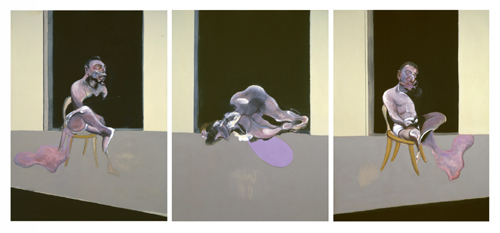
Francis Bacon. Triptych – August 1972, 1972. Oil on canvas, each: 2175 x 1668 x 102 mm painting. Tate © Estate of Francis Bacon. All Rights Reserved, DACS 2007
Tate Britain, London, 11 September 2008–4 January 2009.
Museo Nacional del Prado, Madrid, 3 February–19 April 2009
The Metropolitan Museum of Art, New York, 18 May–16 August 2009
by JANET McKENZIE
The present exhibition is informed by the revelation, following Bacon’s death in 1992, of the contents of his studio. His working methods were revealed, especially his reliance on photographs.
In interviews, Francis Bacon insisted that he never drew, and that his compositions were intuitive. These claims were refuted by the posthumous revelation of figure studies from the 1950s. Bacon usually commenced painting a figure on to the blank canvas. In 1962 he claimed that the genesis of his paintings came whilst daydreaming. In fact his methods were often more orthodox. The works on paper and lists that came to light after his death indicate that he collected a wide range of material to use as points of reference. The present exhibition, which makes a powerful impact on the viewer, comprises 65 paintings and 13 major triptychs. It is the most comprehensive exhibition to date, which examines the artist’s sources, processes and thoughts. It is accompanied by an excellent, scholarly catalogue; edited by Matthew Gale and Chris Stephens; with essays by Martin Harrison, David Alan Mellor, Simon Ofield, Gary Tinterow and Victoria Walsh.1
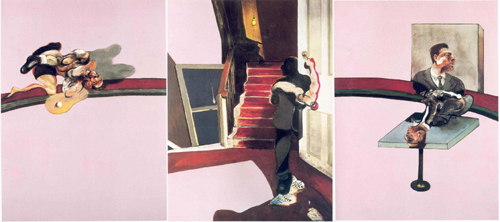
Francis Bacon. Triptych - In Memory of George Dyer, 1971. Oil on canvas 1980 x 1475 mm each. Fondation Beyeler, Basel © Estate of Francis Bacon. All Rights Reserved, DACS 2008 . Photo: Peter Schibli, Basel
Widely regarded as one of the greatest artists of the twentieth century, Francis Bacon can also be seen as one of the most powerful and searing commentators of the human condition in Britain since the Second World War, expressing unflinching images of sexuality, violence and isolation. The exhibition is profound, haunting and iconic. Bacon’s philosophy as an atheist is explored: man in a godless world is presented as simply another animal, subject to the same natural urges of violence, lust and fear. In this Bacon personified the age. The loss of faith in humanity in the late 1940s was such that the human image in art became increasingly difficult to portray. The existential despair expressed by Jean-Paul Sartre in Nausea (1938), found a visual counterpart in the images of despair and alienation of Francis Bacon, the expressionism of Oskar Kokoschka and the apocalyptic visions of Arthur Boyd. For the most part, abstraction in the visual arts dominated because, after the horrors of Auschwitz, Hiroshima and Nagasaki, artists found images of humanity impossible to create.
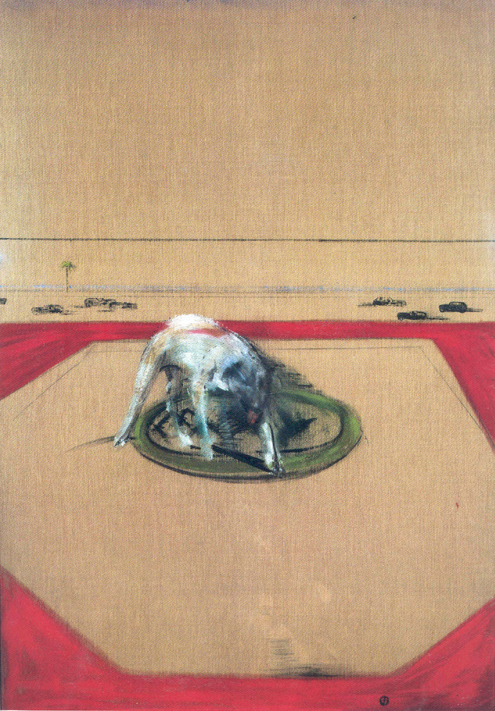
Francis Bacon. Study of a Dog, 1952. Oil on canvas, 2185 x 1580 x 118 mm © Tate
John Berger, formerly a harsh critic of Bacon, recently wrote:
“He repeatedly painted the human body, in discomfort or agony or want. Sometimes the pain involved looks as if it has been inflicted; more often it seems to originate from within, from the guts of the body itself, from the misfortune of being physical”.2
In spite of the hellish drama expressed, Bacon’s work is inspiring in the very dedication to the craft of painting, and the intellectual dialogue created. This is a profound exhibition, at once challenging and awesome. In spite of the bewilderment that can so often be experienced in confrontation with his painting, there is an unexpected affirmation in the choice of formal language and the precision and care applied to the act of painting: the placement of each head, each brush stroke, every subtle hue, the manner in which the figure inhabits the space, the form within the picture plane. A quiet authority is established by the artist amid the shrieking pain, due in large part to the dialogue he has with art from the past.
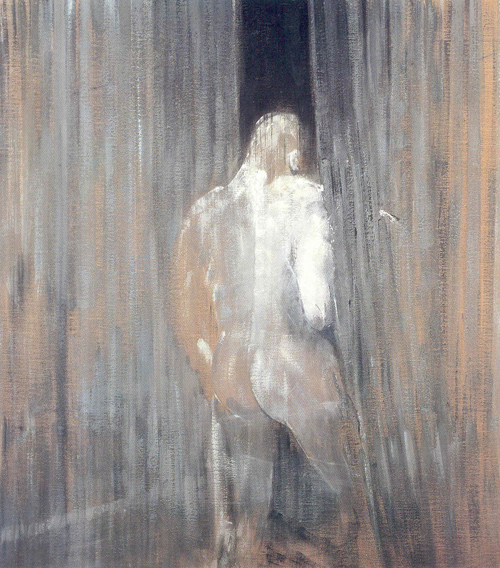
Francis Bacon. Study from the Human Body, 1949. Oil on canvas 1470 x 1342 mm. © Estate of Francis Bacon. All Rights Reserved, DACS 2008
Bacon’s sources have been divided by various commentators now, to include ‘high art’ sources and ‘low art’ sources. Bacon chose only the most remarkable artists to aspire to: Michelangelo, Rembrandt, Velasquez and Picasso. He also chose inspiration from the modern world: men in suits, modern furniture, dangling light bulbs, gay comic books. He depicted a low-life from gangster boyfriends, heavy drinking and sexually dissipated Colony Room artists and intellectuals, a collision of high and low culture, survival and destruction. Chance played an important role in Bacon’s work – spontaneity was of key importance in a Post-Surrealist context. Although he retained the human figure in his work, he embraced the Abstract Expressionists’ love of chance in art as in life. A primordial energy is central to many works, the Bullfight paintings in 1969 being perfect examples of how Bacon infused the image on canvas with a reckless, fatal movement. Describing the collision of illustration of facts and an expression of the very deepest feelings, Bacon noted: “one wants a thing to be as factual as possible and at the same time as deeply suggestive or deeply unlocking of areas of sensation other than simple illustration of the object that you set out to do. Isn’t that what it’s all about?”3
Bacon had the highest ambition from a young age, claiming that his work should either be in the National Gallery or the dustbin, with nothing in between. His ambition as a painter was to define his existential, atheistic stance in a post-photography world. Bacon was a habitual destroyer of paintings; in 1962 he remarked that over-working was a form of destruction, of clogging. Spontaneity was a vital quality, which Bacon sought to capture.
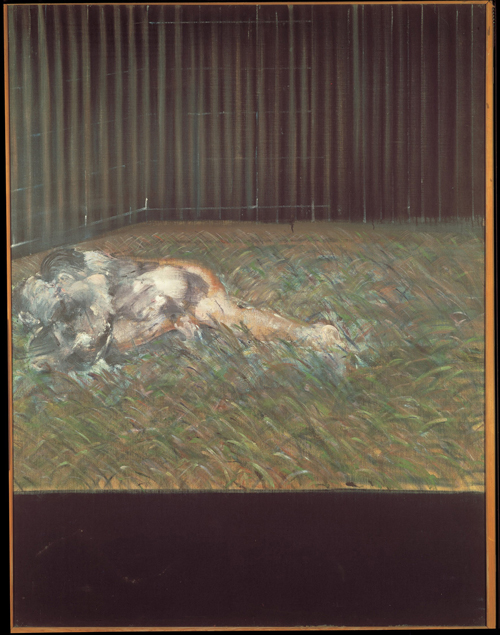
Francis Bacon. Two Figures in the Grass, 1954. Oil on canvas, 1520 x 1170 mm. Private Collection © Estate of Francis Bacon. All Rights Reserved, DACS 2008
Francis Bacon was born in Dublin, in 1909. He spent most of his life in London, working as a self-taught painter from the 1930s. The human figure was central to his work throughout his long and productive career. He died suddenly in Madrid in 1992. Time has played an important part in the appraisal of Bacon’s work; his unflinching approach to violence and the human condition is more poignant than ever. In 1973 he attributed his preoccupation with violence and war to the times in which he grew up, interwar Germany and the rise of Sinn Fein in Ireland:
I grew up in an atmosphere of threat for a long time … And then I was in Berlin at the beginning of the Nazi thing, my whole life had been lived through a time of stress, and then World War Two, anyone who lived through the European wars was affected by them, they affected one’s whole psyche to that extent, to live continuously under an atmosphere of tension and threat.4
The exhibition is accompanied by a catalogue, in which the most scholarly essays, explore the lasting significance of his work for the present day. Images of the abyss, of loneliness and the inescapable suffering of human existence dominate the exhibition.
Francis Bacon at Tate Britain is broadly chronological. Room One, Animal, examines Bacon’s early work from the 1940s where his attitude to humanity is already evident. His bestial depiction of the human figure combined personal feelings of anxiety with broader references to the Second World War. He used reproductions from books, catalogues and magazines. The male figure is used repeatedly in Bacon’s long career; he often includes a scream or shout to reveal the internal repressed and violent anxieties. The open mouth represents the tension that exists between the individual and the broader context of time and place.
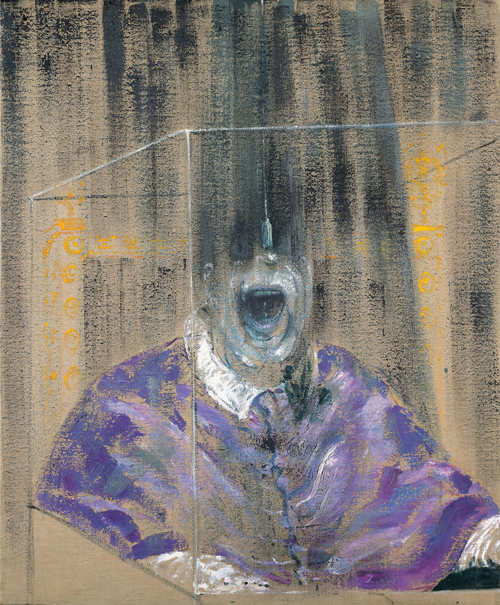
Francis Bacon. Head VI, 1949. Oil on canvas, 932 x 765 mm. Arts Council Collection, Southbank Centre, London © Estate of Francis Bacon. All Rights Reserved, DACS 2008
Room Two, Zone, examines Bacon’s work of the 1950s where he carried out complex experiments with pictorial space. He described the processes, in 1952, as ‘an attempt to lift the image outside of its natural environment’. This work established his easily recognisable images with boxed figures in cage-like structures. Hexagonal ground planes establish tense psychological zones; the use of shuttering, the vertical lines of paint merge the foreground and background. This is the period in which Bacon came of age as a painter. Yet his personal circumstances were extremely difficult: homeless, in debt and in a tempestuous relationship with Peter Lacy. During this time he searched for and found appropriate subject -matter with which to express his deepest anxiety. In the 1950s Bacon used the painting by Velazquez’s Portrait of Pope Innocent X, (c.1650), as his starting point to explore the insecurities of the powerful. For Bacon, the choice of the portrait of a Pope had nothing to do with religion; as a non-believer he was concerned with the way man behaves to each other. For Bacon the portrait by Velazquez was one of the greatest portraits ever painted for it opened up feelings and prompted the imagination, beyond any real individual or other art work. The colour is magnificent, prompting Bacon to give his own images a sense of tragic grandeur, a sense of authority in painterly terms. The Pope as a unique figure in the world suited Bacon’s ambition to create a powerful image in which power is stripped of its essence.
Room Three, Apprehension, explores the pervading anxiety in all of Bacon’s work. The Cold War anxiety that limited movement and personal freedom was combined in Bacon’s case with the illegality at the time of homosexuality. His sometimes, violent relationship, with Peter Lacy, is captured in the Man in Blue series, which concentrates on a single anonymous figure in a dark suit. Although inspired by the greatest artists from history, Bacon powerful images are achieved by combining the authority of the history of art, with contemporary life. The figure is portrayed in isolation, sitting at a table or at a bar. Like many artists in the twentieth century, including the Italian Futurists, who worked with the figure, Bacon drew from the photographic work of Edweard Muybridge’s, The Human Figure in Motion, (1887) sequential photographs of animals and humans, which Bacon described as ‘a dictionary’ of the body in motion.
Room Four at Tate Britain is devoted to one of Bacon’s most famous and iconic series, of the Crucifixion. He made works throughout his career at pivotal moments. As an atheist Bacon saw the Crucifixion as a particularly poignant act of man’s violence. Brutality and fear are developed in a particularly cruel evocation of the famous religious scene. The ritual of sacrifice is given a new dimension, the brutality emphasised with extreme abandon. Meat carcasses are used by Bacon to diminish the human notion of superiority in the wider scheme of life according to Christianity. In an early interview Bacon describes how existing images breed others. He chose the Crucifixion by Cimabue as a starting point, but readily admits that without all the paintings that have been done on the subject, his could not have produced his own. Often under the influence of alcohol, and prone to drug abuse, and frequently suffering acute exhaustion, Bacon would create Crucifixion images of profound despair. He also juxtaposes fragments of films, such as those of Eisenstein, and isolated stills allowing accident to play a major part in the creative process. Three Studies for Figures at the Base of a Crucifixion, (c.1944) is a key work and one that paved the way for his use of the triptych format, and numerous later themes and compositions. The bestial depiction of the human figure was central to Bacon’s oeuvre. Displacing the traditional saints in Crucifixion paintings, Bacon later referred to them as Furies from Greek mythology. In interview with David Sylvester in 1966, he was asked about the use of meat carcasses in these and other works. He stated, “Well, of course, we are meat, we are potential carcasses”.5 Being human in Bacon’s world was utterly debased. Bacon took works from the history of art that were created within a spiritual context and slashed them to bits. In this he felt completely justified, for the Vatican never openly condemned Nazism. This was Bacon’s vendetta for the hypocrisy played out in the name of God. Where artists such as Hieronymous Bosch created devastating images of humanity in works such as his Judgement Day paintings, Bacon chose the traditionally edifying form of portraiture, which entails a degree of trust between painter and sitter, and destroyed it. His disturbing papal images are like the burning of an effigy, leaving the viewer with a sense of physical revulsion.
Room Five Crisis, focuses on the period 1956-1961. Bacon travelled widely in Monaco, France and Africa, mostly with Peter Lacy. He used new methods of painting, choosing thicker paint, strong colour, often violently applied. Using a self-portrait, The Painter on the Road to Tarascon (1888) by Vincent Van Gogh, as his source and inspiration, Bacon painted works that were criticised for their ‘reckless energy’. With hindsight the energy and drama in these works was necessary in introducing chance into the painting process itself.
Room Six is the Archive in the Tate’s exhibition, based on the revelations made by scholars after Bacon’s death. The source material found in Bacon’s studio revealed his reliance on photography and other sources that had not been fully examined during Bacon’s lifetime. There were photographs of athletes, film stills and reproductions of works of art. Further, his practice of commissioning photographs of his friends by John Deakin was fully realised, and formed an important component of the exhibition in Edinburgh, Francis Bacon: Portraits and Heads, (2005). Bacon also took many photographs himself, preferring to draw from photographs, for they were already two-dimensional images. In his studio there were also lists of potential subjects and preparatory drawings, which Bacon had denied making, preferring to emphasise the spontaneous nature of the act of painting directly onto canvas.
Room Seven Portrait, is important given the findings in Bacon’s studio. In descriptions in interviews, most famously those with David Sylvester, Bacon describes his intention to reinvent portraiture. He drew upon the works he admired of Velazquez and Van Gogh. His abiding concern was how a painter should create portraits in an age dominated by photography. He distorted the sitter’s appearance in order to extract a greater, more complete likeness, informed by internal issues of personality and mood. George Dyer his lover is depicted with a mixture of affection and contempt. Three Figures in Room, (1964) expresses a range of human characteristics including absurdity, pathos, and isolation.
Room Eight Memorial, is dedicated to George Dyer, Bacon’s closest companion and model from the autumn of 1963. Two days before the opening of Bacon’s exhibition at the Grand Palais in Paris in 1971, Dyer committed suicide. The void created by Dyer’s death, under such tragic circumstances prompted Bacon to produce a number of works in his memory. The large-scale triptych suited the grand nature of Bacon’s statements, enabling him to isolate and juxtapose simultaneously. The energy in these works is overwhelming. The depths of despair experienced in the loss of his lover, are expressed with consummate skill and heartfelt anguish. Bacon told Sylvester shortly after Dyer’s death: “You don’t stop thinking about them; time doesn’t heal” He referred to his repeated depiction of homosexual copulation as a form of exorcism. Although he regretted its ‘sensational nature’, he was compelled to paint, Triptych, May-June, 1973, “to get it out of his system”. As well as repeated posthumous images of Dyer, he also made numerous self-portraits.6
Room Nine, Epic, examines the work Bacon produced in response to poetry and literature, particularly the work of T.S Eliot. Bacon was emphatic in wanting to make works that evoked the meaning and mood of the written word. They were not illustrations.
For me realism is an attempt to capture the appearance with the cluster of sensations that the appearance arouses in me. As for my latest triptych and a few other canvases painted after I read Aeschylus. I tried to create images of the episodes created inside me. I could not paint Agamemnon. Clytemnestra or Cassandra, as that would have been merely another kind of historical painting when all is said and done. Therefore, I tried to create an image of the effect that was produced inside me. Perhaps realism is always subjective when it is most profoundly expressed.7
Bacon felt a great affinity for poetry, perhaps more so than contemporary art. He appreciated a wide range of poetry ranging from the work of Aeschylus, W.B Yeats, Federico Garcia Lorca, Ezra Pound, William Shakespeare and especially T.S. Eliot. From Aeschylus’ Oresteia Bacon found an evocative image: “the reek of human blood smiles out at me”.8 In turn Bacon admired T.S. Eliot’s recasting of Greek tragedy, seeing in it an appropriate model for modern society. Bacon appreciated Eliot’s preoccupation with, ‘mortality, the pathetic futility and solitude of life’, and the manner in which he located ‘those existential conditions within a specific set of modern circumstances’.9
Bacon’s description of the tightrope between abstraction and figuration can also be used for poetry. “You have to abbreviate into intensity”, he remarked, also an apt description for Eliot’s poetry. Bacon chose painting to assuage the futility of life as he saw it. “I think that man now realises that he is an accident, that he is a completely futile being, that he has to play out the game within reason... You can be optimistic and totally without hope”. Later, he said, “I think of life as meaningless; but we give it meaning during our existence”.10 By contrast, Eliot had a Christian faith and belief in an afterlife.
The use of triptych, Bacon insisted was its resistance to narrative: “it breaks the series up and prevents it having a story, that’s why the three panels are always framed separately”. Yet the sequence created by three canvases side by side could equally create a story through the interrelatedness of the three images and specific references within each. Specific intended meaning is always speculative in Bacon’s work. The triptych emphasises Bacon’s fascination with theatrical devices to observe the human condition. Likewise Eliot’s Wasteland, ‘describes specific scenes and events but does not tie them to a single story’.11
Room Ten Late, examines the last decade of Bacon’s life. The confrontation with mortality was an abiding theme in his work, having lost key figures in his life already. In 1993 he stated: “Life and death go hand in hand …Death is like the shadow of life. When you’re dead, you’re dead, but while you’re alive, the idea of death pursues you”.12 The very black paintings made in the 1970s which confronted the death of George Dyer, gave way to more contemplative works, with a palpable restraint and composure. In several paintings he draws on his admiration for the work of the nineteenth-century French painter Jean-Auguste-Dominique Ingres. Numerous reproductions of Ingres’ work were found in his studio, which he combined with incongruous images from sporting figures. Bacon also employed a controlled element of chance by throwing paint at the canvas. The aftermath of violence, blood gushing from a victim onto the pavement, for example, Bacon found exhilarating. Blood on Pavement, (c1988) is presented with the artist’s extraordinary detachment. “Things are not shocking if they haven’t been put into a memorable form. Otherwise, it’s just blood splattered against a wall.”13 The theme of detachment from violence and suffering is achieved throughout Bacon’s oeuvre, from an early Wound for a Crucifixion (c.1934) to the Bullfight works in the 1960s to Oedipus and the Sphinx after Ingres, (1983). The last paintings are the antithesis of Bacon’s early frenzied works, and have been criticised for being formulaic and lacking in tension. They have a monumentality and order, yet returning to the same themes that had occupied him for forty years. His last triptych of 1991 returns to the issue of sexual struggle, which permeates much of his life’s work. His most private feelings are laid bare, and to which he referred in 1971/3, “I’m just trying to make images as accurately off my nervous system as I can. I don’t even know what half of them mean. I’m not trying to say anything”.14
References
1. Matthew Gale and Chris Stephens, Francis Bacon, Tate Publishing, London, 2008.
2. John Berger, “Prophet in a pitiless world”, The Guardian, 29 May 2004.
3. Gale and Stephens, “On the Margin of the Impossible”, op.cit., p.26.
4. Quoted by Stephens, “Epic”, op.cit., p.218.
5. Quoted by Matthew Gale, “Crucifixion”, ibid, p.137.
6. Chris Stephens, “Epic”, ibid, p.214.
7. Ibid, p.216.
8. Gale and Stephens, op.cit., p.26.
9. Ibid, p.26.
10. Ibid, p.26.
11.“Epic”, op.cit., p. 213.
12. Rachel Tant, “Late”, p.233.
13. Ibid, p.233.
14. Ibid, p.237.